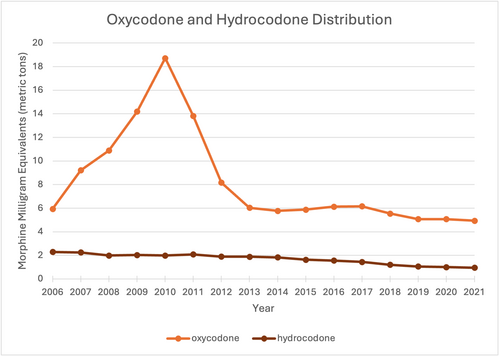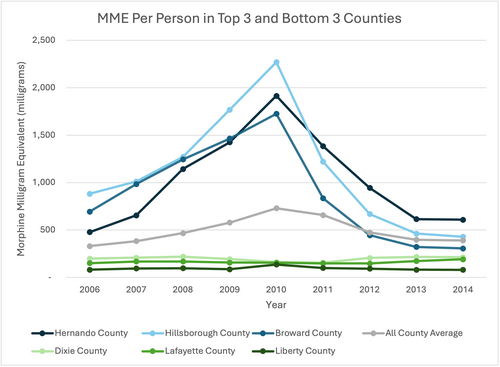
03 Jul New analysis of a Washington Post/DEA Database Identifies Contribution of Lax Policies on Florida’s Sizable Distribution of Prescription Opioids
MedicalResearch.com Interview with:

Elena Stains
Medical Student
Department of Medical Education
Geisinger Commonwealth School of Medicine
Scranton, PA
MedicalResearch.com: What is the background for this study?
Response: Opioid use has been an increasing problem since the early 2000s in the United States (US) with a surge around 2010. Twenty-five percent of those having abused pain relievers in 2013 and 2014 got those drugs from physicians1. Physicians are particularly well-known for fueling the opioid crisis in Florida in the 2000s. Of the United States’ top 100 opioid prescribing physicians in 2010, an astounding 98 were prescribing in Florida2. Florida taking the main stage of the opioid crisis can be attributed to several factors, including ability of physicians to dispense opioids directly from their offices to patients (i.e. without pharmacists) and the presence of many infamous “pill mills” in the state3–6.
The researchers at Geisinger Commonwealth School of Medicine aimed to analyze the amount of hydrocodone (including brand names of Vicodin and Lortab) and oxycodone (OxyContin and Percocet) distributed in Florida from 2006 to 2021, paying close attention to the peak year of the opioid crisis, 2010. The team used the Washington Post and the US Drug Enforcement Administration’s Automation of Reports and Consolidated Orders System (ARCOS) databases to compile this compelling information.
MedicalResearch.com: What are the main findings?
Response: The amount of opioid distributed in Florida during the peak years of the opioid crisis was stunning. In 2010, there were 18.72 metric tons of oxycodone distributed in the state—an increase of 215% from 2006. The general thread of events is that oxycodone distribution increased rapidly from 2006 to 2010, peaked in 2010, and then fell about as sharply as it rose by 2014. Distribution stayed rather steady from 2014 to 2021, at levels slightly lower than 2006. Hydrocodone, however, did not follow this pattern and instead decreased 58% from 2006 to 2021.
In 2009, oxycodone and hydrocodone distribution directly by providers accounted for 10.9% of the total—something somewhat unique to Florida. Florida allowed providers to dispense opioids directly to patients until banning the practice in 2011. Three counties rose above the rest in distribution—Hillsborough, Hernando, and Broward. The average morphine milligram equivalent (MME) per person in Florida in 2010 was 729.4—in Hillsborough that year, it was 2,271. For context, 2,271 MMEs equals 2,271 milligrams of hydrocodone or 1,514 milligrams of oxycodone. If one oxycodone pill is 10mg, that is almost 152 pills per person in one year.

Figure 1. Oxycodone and hydrocodone distribution in morphine milligram equivalents (MME) in metric tons from 2006 to 2021 based on the United States Drug Enforcement Administration’s Automation of Reports and Consolidated Orders System (ARCOS) data.

Figure 2. MME per person in the top three distributing counties (Hillsborough, Hernando, Broward) and the bottom three distributing counties (Dixie, Lafayette, Liberty) from 2006 to 2014. The all-county average 2006 to 2014 is also plotted.
MedicalResearch.com: What should readers take away from your report?
Response: This report is a unique dive into a national issue. Opioids have affected Americans all over the country, and Florida is a fascinating example of the consequences of malicious prescribers, often enabled by pharmacists5,7, and lax laws. Florida ranked 13 out of 50 states in opioid death rates in 20108.
Fortunately, in 2009 Florida created a prescription drug monitoring program (PDMP) and, perhaps more importantly, in 2011 passed HB7095 which banned direct dispensing of opioids from providers’ offices and allowed for stricter regulation of prescribing. Studies have found that the PDMP was associated with a 25% reduction in opioid overdose deaths in the state between 2010 and 20129.
Florida’s story is dramatic. It not only warns of the dangers of opioid over-prescription but also proves the benefits of PDMPs and stricter regulation. This study allows readers to track the opioid crisis through the years in Florida with concrete data.
MedicalResearch.com: What recommendations do you have for future research as a results of this study?
Response: This novel pharmacoepidemiologic report suggests a correlation between the amount of opioids distributed in Florida and their implementation of stricter prescribing and dispensing regulation. Helpful future research would dive further into this association and tell us how PDMPs and other laws can decrease opioid-related deaths and what more we can do to halt the opioid crisis.
MedicalResearch.com: Is there anything else you would like to add? Any disclosures?
Response: Policymakers in the US and internationally can benefit from understanding the results of this study. Our data shows a clear uptick in distribution in distinct counties and areas of the state. Other counties saw no change in distribution. Policymakers, politicians, and community leaders should use the data provided in this study to examine their jurisdictions and enact impactful improvements.
New Report
Stains EL, et al. Dynamic changes in the distribution of oxycodone and hydrocodone in Florida from 2016 to 2021. Pharmacy 2024-in press, https://www.mdpi.com/2226-4787/12/4/102
Citations:
- Lipari RN, Hughes A. How People Obtain the Prescription Pain Relievers They Misuse. Accessed May 16, 2024. https://www.samhsa.gov/data/sites/default/files/report_2686/ShortReport-2686.html
- Johnson H, Paulozzi L, Porucznik C, Mack K, Herter B, Hal Johnson Consulting and Division of Disease Control and Health Promotion FD of H. Decline in drug overdose deaths after state policy changes – Florida, 2010-2012. MMWR Morbidity and mortality weekly report. 2014;63(26):569-574.
- Appropriations Committee, Health and Human Services Committee, Judiciary Committee. HB7095. Florida State Legislature; 2011.
- Office of Public Affairs. Pain Clinic Owner Sentenced for Role in Operating Pill Mills in Tennessee and Florida. United States Department of Justice; 2020.
- Logan Neill. Pill Arrests Net 53. Tampa Bay Times. March 12, 2011.
- Rick Ramirez. Pill Mills: An Overview of Law Enforcement’s Painful Challenge. Florida Department of Law Enforcement. Published September 2011. https://www.fdle.state.fl.us/FCJEI/Programs/SLP/Documents/Full-Text/Ramirez,-Rick-paper.aspx
- Tony Marrero. At Odds in Pill Mill Battle. Tampa Bay Times. March 17, 2011.
- Kaiser Family Foundation. Opioid Overdose Death Rates and All Drug Overdose Death Rates per 100,000 Population (Age-Adjusted). https://www.kff.org/other/state-indicator/opioid-overdose-death-rates/?currentTimeframe=0&sortModel=%7B%22colId%22:%22Location%22,%22sort%22:%22asc%22%7D
- Delcher C, Wang Y, Wagenaar AC, Goldberger BA, Cook RL, Maldonado-Molina MM. Prescription and Illicit Opioid Deaths and the Prescription Drug Monitoring Program in Florida. Am J Public Health. 2016;106(6):e10-e11. doi:10.2105/AJPH.2016.303104
The information on MedicalResearch.com is provided for educational purposes only, and is in no way intended to diagnose, cure, or treat any medical or other condition.
Some links may be sponsored. Products are not endorsed.
Always seek the advice of your physician or other qualified health and ask your doctor any questions you may have regarding a medical condition. In addition to all other limitations and disclaimers in this agreement, service provider and its third party providers disclaim any liability or loss in connection with the content provided on this website.
Last Updated on July 3, 2024 by Marie Benz MD FAAD
